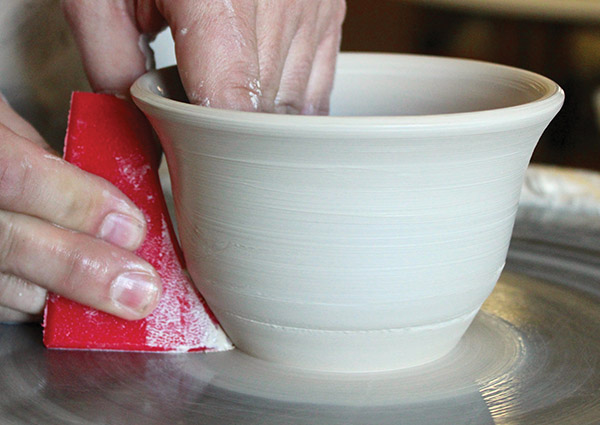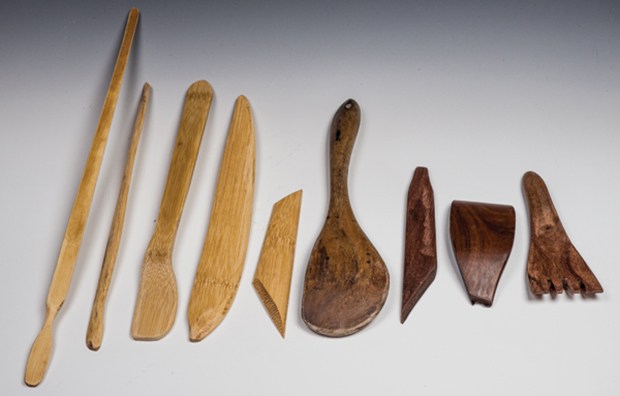

Using pottery throwing ribs correctly is an important skill to learn in order to produce consistent pots with clean surfaces. There are a ton of pottery throwing ribs out there to choose from and it might not always be obvious how they are intended to be used. Also, there are times when you need to create your own clay ribs to tackle a particular job.
In today’s post, an excerpt from the Pottery Making Illustrated archive, production potter Jared Zehmer demonstrates how to use both common and less common pottery throwing ribs to their greatest potential.
Tips and Ideas for Pottery Throwing Ribs
Proper Use of Pottery Throwing Ribs
There’s no doubt that the proper use of pottery throwing ribs is essential to throwing well-surfaced and consistent pots on the potter’s wheel. However, with the wide variety of ribs out there it may at times be tricky to match a rib to your specific needs when shaping and finishing the surface of a pot, as well as to utilize a specific rib for its intended purpose. Let’s look at some of the basics of the more common pottery throwing ribs available, as well as introduce a few ideas for some modified and do-it-yourself ribs, all of which I have found work the most efficiently and consistently in my experience as a production potter. However, these demonstrations will certainly not cover each rib’s full potential as a useful tool for texture and design that’s limited only by the artist’s experimentation and imagination.
Wood Pottery Throwing Ribs
Wooden ribs are probably the most commonly used wooden rib in pottery and is found in most pottery start up kits. I likely use one every time I’m at the wheel as it’s a versatile and useful tool and a great beginner’s rib. When brand new, these ribs have a nice sharp edge, which is necessary for producing clean and straight surfaces. Over time, the edge dulls, but it can be easily brought back to life with a sander. The cylinder is about 1½ pounds of white stoneware I have just finished pulling into a basic starting form.
Kitchen Countertop Sample Throwing Ribs



Here’s an example of a DIY rib. This is a kitchen countertop sample—they are free and plentiful at most home or flooring sales stores. What makes this a great rib is that it’s thin and rigid. Since the edge of this makeshift rib is so thin, there’s no need to keep its edge sharpened like the common wooden rib, so it will always leave behind a nicely cleaned and straight wall.
Just like in the first example, press into the edge of the rib from the inside of the cylinder from bottom to the top (1). Held flush against the wheel at about a 45° angle, this rib will also give a clean undercut to the bottom of the vessel.
Cutting-Board Throwing Ribs
Another example of a DIY rib is the custom profile rib shown below, which I have made out of a plastic cutting board. This was made by tracing a form onto a cutting board, cutting it out with a jig saw, then using a Dremel tool with a sanding wheel bit to bevel and sharpen the edges, much like the edge of a basic wooden tool. Often I am tasked with making large numbers of matching bowls, so I find that a curved profile tool with a flat wide bottom that sits flush on the wheel head can help with quick shaping, surface cleaning, and consistency. Once you get the hang of using the curved profile of this tool, it can be used for a variety of different sizes of bowls.
Resting the wide base of the rib flush with the wheel head, I push the pointed tip of the rib into the foot of the vessel quite far. Even if the foot of the pot is naturally wide, it can be pushed into a tighter foot prior to finishing the final shaping (2). Once the width of the foot is established, I push out into the contour of the rib from the inside of the bowl from bottom to top, forming the curve of the bowl (3).
Since the top of the rib’s profile is curved, I can use that contour to roll the lip of the bowl into a nice, laid-over rim. The rib does most of the work here, simultaneously shaping and cleaning the outside of the bowl.
This white cutting-board rib shown below has the same contour as the red one; however, the top of the profile breaks off at a near 90° angle. After the form of the bowl has been made using the curve of the rib, the upper wall of the bowl is pushed into the top edge of the rim so it can create an aesthetically pleasing break underneath the rim of the bowl (4). If you don’t have the tools to make your own, a number of ceramic suppliers offer contour ribs.
Modified Wooden Foot Rib
This is a basic wooden rib I have modified to create an instant foot at the base of forms (5). Using a sander, I have straightened out and beveled the original curve of the rib’s upper profile and using a Dremel tool with a sanding bit, I have nicked out a curved “bite” in the tip of the rib, which I use to create a foot. The vessel in this example is a larger 2-pound bowl that will be shaped and footed with this rib.



Press the tip of the rib into the base of the pot to create the foot. Again, the rib can be pressed even deeper into the base, creating a narrower foot as the excess clay will be shaved off by the rib (5). Don’t be afraid to press deep into the base of your form—the tighter the foot, the more elegant the shape.
Press into the edge of the rib from the inside of the bowl after removing the tip from the foot and continue shaping the pot’s profile (6). Finish shaping the wall and lay over the rim for a graceful footed bowl.






